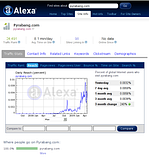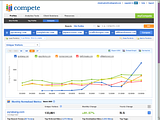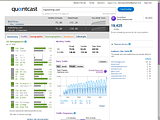This is an introductory article written for the novice. Experienced bloggers, webmasters, and SEO freaks may find some useful content here, or you can just skip down to my list of Additional Resources.
If you have your own website, blog, or bulletin board forum, one of the very first questions you'll ask is: "How many people visited the site today?" While stating the importance of web traffic is obvious, it turns out that measuring web traffic with any degree of accuracy is not that easy. In fact, fifteen years after the First International WWW Conference in 1994, there is still no universally agreed upon strategy for the gathering and interpretation of web traffic data.
How Hard Can It Be Just To Count (Virtual) Heads?
Well, to be fair, there's more involved than mere arithmetic. Here's a definition from the Web Analytics Association, or WAA (yeah, I know, almost as silly as the Wii), an industry standards trade group:
Web Analytics is the measurement, collection, analysis and reporting of Internet data for the purposes of understanding and optimizing Web usage.
Okay... Let's try to KISS this verbiage. For me, the goal, at least, of web analytics is simple: I want to know everything possible about the visitors to my site. Additionally, as an online entrepreneur, I want to know as much as possible about my competitors' sites, and their visitors, as well. Getting a handle on the different ways & means of measuring (the metrics) is fundamental to the growth and prosperity of my business.
So now we identified the problem; what's the solution? What tools and tactics are available to us? For the purposes of this tutorial we can broadly divide our options into two different methods: census-based and panel-based.
The census method, as you've probably guessed, involves the direct measurement of visits to a given URL. Historically, the server logs were the most immediate source of raw data. Server logs are still very much used today -- by System Administrators of medium-sized and larger companies, mostly. For the vast majority of individuals and small business owners who use a remote web hosting company, access to the server logs isn't an option. Instead, a number of reputable third-party firms provide snippets of JavaScript code that you can insert into the HTML templates or individual pages that you want to track on your site. We will examine two free online census, or embedded "tag" services in a moment.
The panel method involves sampling the web surfing behavior of volunteer focus groups, and then extrapolating, or generalizing the panel's results for a whole nation, or the entire world even. Critics have pointed out the biases and limits of this approach; however, it is unreasonable to expect that census tagging will ever cover a majority of the billions of active web pages. So panels are still helpful. My preferred technique is to combine both methods. This hybrid approach then yields some very powerful insights.
Four Free Tools To Get The Job Done
Let's deal with the worst, first. Alexa is familiar name to many; a subsidiary of Amazon.com, they employ the panel model for their rankings, which are often quoted as the definitive authority. Their biggest plus is ease of use; you don't need to register, give an email, or anything, to access their information. Just type a domain name into their search bar and presto, you get a Rank number and a graph, like this:

Looks pretty good, right?
Sorry, folks, but Alexa kinda sucks. Yes, they rank millions of domains -- probably yours, too -- and, yes, they've been doing this for a long time, so they should be good at it. Well, there are many reasons why Alexa's numbers are suspect. First of all, only people who download and install their toolbar have their traffic and surfing analyzed. As Peter Norvig has informally observed, the kinds of folks who install Alexa's toolbar (like me), tend to be more interested in it's specific Search Engine Optimization (SEO) features. So that means that webmasters & geeks tend to be overrepresented. Norvig is a renowned computer scientist and currently Director of Research at Google, so his opinion carries some weight.
The other less obvious, but much more serious, flaw with Alexa is that their algorithms grossly favor social traffic over search-driven traffic. So much so that two sites with roughly the same number of unique daily visitors can have rankings a million spots apart! Ridiculous. The well-known "Make Money Online" blogger, Grizzly, thoroughly documented this problem back in January. Basically, if your ecommerce is heavily dependent on Pay-Per-Click (PPC) or Google Adsense display ads, then Alexa is going to give you garbage. And social websites will get garbage in the other direction. Of course, we all know the world needs more vanity bloggers with an overinflated sense of their importance. Use Alexa with extreme caution.
Compete.com boasts that they are "a new breed of web analytics company". Also panel-based, but they claim to be larger and smarter about it. They offer very detailed reports for their paid Pro members; however, there's some really nice features available for free. Name and email registration is required, but then you get to combine site AND search analysis on up to five sites simultaneously. For example:

This shows one-year traffic history by default; 3-month, and 6-month views are only a click away. Even better, you get get referring and destination sites to and from a given domain, PLUS the top five keywords that drove the traffic. Very handy, indeed.
Compete's graphs are color-coded and uncluttered and interactive -- in short, they're user-friendly. They distill many complexities into an easy-to-absorb format. This service should definitely be in your web analytics toolbox. The only downside that I'm aware of at this time is that so far Compete has limited their reporting to US sites only.
Google Analytics is the impressive census model service from the search engine giant. It's so impressive, that I hardly ever use it. Why? Well, maybe I'm a little bit cynical, but it seems to me that the main goal of this tool is to get enterprise-class businesses to buy more Adwords. All Internet Marketers are painfully aware of our dependence upon the "800-lb gorilla". So... hypothetically speaking, the same company that hosts my blog (Blogger), sells me text ads, controls my SERPs, arbitrarily slaps my PageRank, and unilaterally determines what my Adsense real estate is worth, is now going to offer me web traffic analysis and content data mining out of the goodness of their heart? Do I really think that such an asymmetrical relationship is a good thing? I know my answer. You'll have to decide for yourself. Having said all that, I still signed up and installed the JavaScript tag, anyway, dammit.
Quantcast is a hot West Coast startup company with a growing stable of top-notch publishers that are using their code-based census analytics. They provide free online rankings of the Top 1 Million Sites, and if you search a domain that is tagged, you get detailed demographics, and info on the "also visits" sites. For all other non-tagged sites, they give "Rough Estimates". I appreciate the honesty. Like Google, it's free but you have to register and paste their code into your own pages. Here's a screenshot:

Of the four services, none of them provides a complete picture. For domains based in the United States, I would recommend Compete combined with Quantcast. International sites, unfortunately, have to make do with Alexa, adding Google and/or Quantcast for balance.
Web Analytics is a deep subject; this article is meant to just open the door for beginners. With multiple free choices, there is no reason or excuse not to use at least one of each methodology, census and panel. I happen to like math, and the theoretical (if not actual) purity of data for its own sake; so I use all four tools. If you're new to crunching your own numbers, my advice is to not get bogged down in minutiae. Staring at too many pie charts can lead to "analysis paralysis" as I call it. Especially when Internet properties first go live, there are going to be wild swings in traffic; spikes and valleys are normal at first. Or maybe the site traffic is basically flat -- that means to stop moping over your spreadsheet and start building backlinks, or do more promoting on the Traffic Exchanges -- you get the idea.
Then, when you come back to the data, you can use the information below to further your expertise.
Additional Resources
- Web Analytics on Wikipedia
- Technology Review: But Who's Counting? a lengthy but insightful profile of the major corporate players in the field, with emphasis on the expense of traffic uncertainty.
- Occam's Razor an excellent Web Analytics Blog covering advanced topics in lucid language. I'm pretty sure the author, Avinash Kaushik, is another Google evangelist, but, hey, nobody's perfect.

